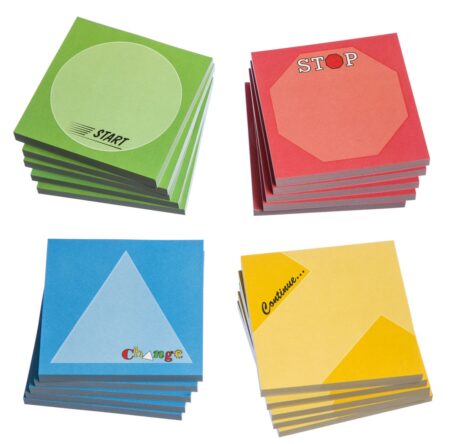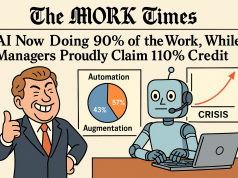[ad_1]
Training closers can be make-it or break-it experiences. I asked my LinkedIN crew for their suggestions on the best ways to close a learning event for maximum impact and retention. As always, the group came through, sharing their favorite training closers for getting closure at the end of a training day.

Start-Stop-Continue-Change Sticky Notes BUY NOW
Use it or Lose it!
- “I tell the delegates that, despite good intentions, most training is wasted. When they get back to work, they will be overwhelmed by day-to-day demands and will stop thinking about what they learned. Only if they use something from the course in the next 2 days will it become part of what they do. So, I ask each person to think about what work is awaiting them and choose one thing they will do differently at once because of the course. Then I go round and everyone gives their action.” ~ Pamela Hunt
- “I ask my participants to list three things that they’ll do going forward. Then, I ask that they share their list with their manager and one other person so that they are held accountable. This training closer is simple but effective.” ~ Michelle Johnson.
- “I like to engage the audience in training to enable not just understanding but applying in the real world! One tip I found was to ask them to review the key points in 24-48 hrs based on the OBJECTIVES of class = learner retention. Second, if there are ACTIONS they can do as ‘follow up’, that’s powerful. Thirdly, if there are former attendees who have been ‘to the field’, I encourage them to connect with them.” ~
Training Closers for Next-Day Prep
- I close each day and begin the next one by assigning “homework” to review the skills they’ve learned from the agenda that day and think of a way to apply one or more in their current workflow/projects. Then, we begin the next class by having folks share their use cases to hopefully inspire others to connect the dots in new ways.~ Candice Belandres
- I ask my groups to review their handwritten notes and highlighted handouts for key learning points. Then I do a round-robin, asking each individual to share a key learning point. ~Chris Reavley
Every little bit helps…
- The Starfish Story: “When training customer service or soft skills, I like to end with the starfish story. I typically play a video that I found on YouTube that tells a story. Briefly… A man walks up to a boy throwing starfish back into the ocean as the tide is ebbing. The man tells the boy that there are millions of starfish and his actions won’t help. The boy tosses another and says, it will help that one.’ Explain to your group that they may not be able to help every person in the world, but they can help the one standing in front of them if they put the correct effort into it.” ~ Michelle Johnson
- Scott’s Moose Story – a metaphor for teamwork, persistence, and continuous improvement: Scott Simmerman has used this for 30+ years, to wrap up sessions and focus on the need for incremental progress. Scott generously shares his slideshare. Here’s a synopsis:
- Show a slide of key learning points.
- Ask “Is what we did today a lot like hunting moose…?”
- Expect confusion, and explain: “a moose … a large horselike animal with antlers.” As expected and intended, they’ll still be puzzled.
- Tell the story: 3 hunters return to Alaska to hunt moose at the same lake they visited last year. Their pilot flies them in using a float plane and says he’ll return in 3 days. The men have a wonderful, successful hunt. When the pilot returns, the hunters load a moose onto the pontoons. When the pilot says, “Let’s go!” the hunters reply, “not yet, we have two more moose!” After some argument, the pilot relents and they load the other two moose onto the pontoons. When they’re all loaded up, the pilot taxis down the lake, revs the motor, and takes off, moving faster and faster into the air. [dramatic pause]. Suddenly, the pontoons hit the top of the trees, causing the hunters and gear to go flying. They call out to each to make sure everyone’s okay… After a few minutes, one asks: hey, where are we? They look around and say “looks like we’re about 50 feet farther than last year!” [pause for reflection]
- Ask again: how our learning is like hunting moose and hopefully they will see the point.
- The moral: learning isn’t about final success, but growth, improvement, and incremental progress.
- Relate it to the real world: how can an improvement of “50 feet” help them and the organization?
Group-Write Training Closers
- Posters: “Set up 3 large, empty poster boards and label them: THINGS I KNOW, THINGS I LEARNED, and THINGS I WANT TO LEARN MORE ABOUT. I ask each person in the class to write on each poster. Then, we all take a step back to see what the class as a whole can take away or learn more about.” ~ Candace Belandres
- Whiteboard: Ask them all to jot down keywords ( leanings) or draw on a whiteboard if available and then click a selfie to share with all. ~ Kunal Shrivastava
- Sticky Notes Stories: Ask the teams to summarize the key takeaways as a small presentation or collate sticky notes on a board with the key takeaways or feedback. You can gamify this by building different picture takeaways or stories and asking teams to guess the takeaway. They might also want to take a selfie with one of the stories or sticky notes. ~ Abhipsa Mishra
- Letter by Letter: Divide the participants into groups. Give each team a piece of paper with 5 different letters–the letters can spell a word, or be chosen at random. Each team is to come up with 5 different things they learned, each beginning with one of those five letters. It is engaging, recollecting concepts and conjuring words in line with them. ~ Sri Ram Kumar
Paper Airplane
- Give everyone a piece of paper and ask them to write a question that’s been answered during the session. Then have them make a paper plane from that paper. Next, have participants stand in two rows, facing each other. Spend 30 seconds or so throwing the planes back and forth. When time is up, have each person randomly pick up an airplane. In turn, ask each to unfold the plane, read the question, and try and answer it – people on either side can help if needed. No pressure if they can’t… anyone can help answer any question! This training closer and lots more review activities can be found in the 101 Training Activities Book ~ Derek Good
Energy & Pizzazz
- It all depends on the topic and the audience. When I taught sales associates, brain-dead after two weeks of intense training, I would have them cheer at the top of their lungs. I would not let them leave until employees could hear them on the other side of the building. They loved it! Executives would say, “I heard you had another class last week.” If it’s a leadership class, I try to end with an inspiring quote. The point is to have the participants leave on a natural high. ~ Lynda Goldberg
Personal Written Reminders
- Write or illustrate 2-3 things you learned or would like to implement on a blank index card or wallet-sized card. Distribute plastic DocU-Sleeves or baseball card holders to protect the notes for future reference.
- Write key learning points on a desktop squeeze toy, like a Reminder Hand, Light Bulb, or anything else pertinent to your subject matter.
- Write a letter to yourself that will be delivered in 30 or 60 days. Highlight something you learned or hope to be reminded of in the future. The facilitator can mail the letters or attendees can keep the notes in a sealed envelope with the writing “DO NOT OPEN UNTIL xx/xx/xx.”
- Jot some notes on a “3-2-1 I GOT THIS” notepad, including 3 things I learned, 2 actions to apply what I learned, and 1 way I’ll share my learning.
Ask questions that require thinking, sharing, and commitment
- What and When? I ask participants to think about one thing they have learned or enjoyed during the workshop. Then we go around and share it with each other, adding insights to each other’s items. It allows the reviews to come from the learners, and it personalizes the experience for them. Next, I ask, “what’s one thing you will do because you attended?” And, “When will you do it?”
- What? So What? Now What? The focus of these questions is: What have you learned? So what, what is the significance of the learning? Now what are you going to do or change going forward?
- Works Well. Do Differently. With these two simple questions, “What worked well?” and “What could you do differently going forward?”, facilitators can help their groups explore what actions foster positive results and where they see opportunities for growth or change. The key is that it frames this self-critical exercise in positive, non-threatening terms.
- WHOA! AHA! HMM! Ask groups to share their “aha” learning moments, “whoa” experiences that surprised them, and “hmm” pensive, pondering observations.
- START-STOP-CONTINUE-CHANGE: In this format, participants can write down the actions they hope to start, stop, continue, or change on a set of sticky notes.
Celebrations and Souvenirs
- Small Take-Aways: In a corporate training session, I usually have a wrap-up slide and end the session by giving a small souvenir that I have pre-made on various topics such as a bookmark containing a quote or a keychain with a title of the training program. ~
- Appreciation: Seat all participants in a circle and give them a blank sheet of paper. Ask each participant to write their name on the bottom of the sheet and then pass it to their right. Each time a participant receives a sheet of paper, they must write something they appreciate about the person named at the bottom. When all are done writing, those sheets are passed along again and again. Continue until everyone has received and written on every sheet and it’s returned to its starting place. Take a moment while each person reads through all of their peers’ positive reflections. Find complete notes for the exercise here ~ Dr. Nick Heap
- Gold Stars or Trophies: Reward attendees with a gold star or trophy, then ask them to give an acceptance speech. Hilarious!
Read More
- Mark Dawdy, referenced the Bob Pike Group’s 50 Creative Training Closers, a book chock full of ideas for closing a training event with impact.
- The Perfect Debrief
The post Training Closers to end a Learning Day appeared first on WorkSMART: Tips for a happier, more engaged workplace.
[ad_2]
Source link




























